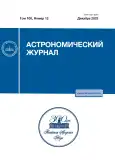RATE OF SOLAR NANOFLARES IN DIFFERENT SPECTRAL RANGES
- Autores: Belov S.A.1,2, Zavershinskii D.I.1,2, Bogachev S.A.1,3, Ledentsov L.S.1,4
-
Afiliações:
- Samara National Research University
- P.N. Lebedev Physical Institute of the Russian Academy of Sciences
- Space Research Institute of the Russian Academy of Sciences
- Lomonosov Moscow State University, Sternberg Astronomical Institute
- Edição: Volume 100, Nº 12 (2023)
- Páginas: 1322-1331
- Seção: Articles
- URL: https://journals.rcsi.science/0004-6299/article/view/233476
- DOI: https://doi.org/10.31857/S0004629923120010
- EDN: https://elibrary.ru/DBLBOI
- ID: 233476
Citar
Texto integral
Resumo
The frequency and rate of solar nanoflares (NF) were measured in 6 coronal spectral ranges (094, 131, 171, 193, 211, 335 Å) and one, related to the transition layer (304 Å). We used SDO/AIA data obtained at solar minimum in May 2019. We analyzed the same region of the Sun, covering \(360\text{\textquotedblleft} \times 720\text{\textquotedblleft}\) field-of-view, in all channels over the same time interval of 1 hour. In all the spectral bands, to search for NF we applied the same algorithm based on the amplitude analysis of fast brightenings in AIA images. The frequency and rate of NF, as can be expected, vary significantly in different wavelengths. For threshold \(5\sigma \), the highest NF frequency, 207 c–1, was measured in 171 Å. The next spectral ranges are 193 Å (85% of 171 channnel), 211 Å (74%), and 131 Å (63%). We have not been able to reliably measure the frequency in channels 094 Å, and 335 Å, but found that it is less than 15% of the frequency in channel 171 Å. In the 304 Å channel, we found a large number of brightenings that do not match any coronal events. However, about 40% of NF in corona have a counterpart in the 304 Å line with an amplitude higher than \(5\sigma \).
Palavras-chave
Sobre autores
S. Belov
Samara National Research University; P.N. Lebedev Physical Institute of the Russian Academy of Sciences
Autor responsável pela correspondência
Email: mr_beloff@mail.ru
Russia, Samara; Russia, Moscow
D. Zavershinskii
Samara National Research University; P.N. Lebedev Physical Institute of the Russian Academy of Sciences
Email: mr_beloff@mail.ru
Russia, Samara; Russia, Moscow
S. Bogachev
Samara National Research University; Space Research Institute of the Russian Academy of Sciences
Email: mr_beloff@mail.ru
Russia, Samara; Russia, Moscow
L. Ledentsov
Samara National Research University; Lomonosov Moscow State University, Sternberg Astronomical Institute
Email: mr_beloff@mail.ru
Russia, Samara; Russia, Moscow
Bibliografia
- S. A. Bogachev, A. S. Ulyanov, A. S. Kirichenko, I. P. Loboda, and A. A. Reva, Physics Uspekhi 63, 783 (2020).
- L. Golub, A. S. Krieger, J. K. Silk, A. F. Timothy, and G. S. Vaiana, Astrophys. J. 189, L93 (1974).
- S. Krucker, A. O. Benz, L. W. Acton, and T. S. Bastian, Astrophys. J. 488, 499 (1997).
- J. P. Delaboudiniere, G. E. Artzner, J. Brunaud, A. H. Gab-riel, et al., Solar Phys. 162, 291 (1995).
- B. N. Handy, L. W. Acton, C. C. Kankelborg, C. J. Wolfson, et al., Solar Phys. 187, 229 (1999).
- S. Krucker and A. O. Benz, Astrophys. J. 501, L213 (1998).
- D. Berghmans, F. Clette and D. Moses, Astron. and Astrophys. 336, 1039 (1998).
- M. J. Aschwanden, R. W. Nightingale, T. D. Tarbell, and C. J. Wolfson, Astrophys. J. 535, 1027 (2000).
- C. E. Parnell and P. E. Jupp, Astrophys. J. 529, 554 (2000).
- A. S. Ulyanov, S. A. Bogachev, A. A. Reva, A. S. Kiri-chenko, and I. P. Loboda, Astron. Letters 45, 248 (2019).
- J. R. Lemen, A. M. Title, D. J. Akin, P. F. Boerner, et al., Solar Phys. 275, 17 (2012).
- S. Purkhart and A. M. Veronig, Astron. and Astrophys. 661, id. A149 (2022).
- V. Joulin, E. Buchlin, J. Solomon, and C. Guennou, Astron. and Astrophys. 591, id. A148 (2016).
- W. T. Barnes, M. C. M. Cheung, M. G. Bobra, P. Boerner, et al., J. Open Source Software 5(55), 2801 (2020).
- W. T. Barnes, M. G. Bobra, S. D. Christe, N. Freij, et al., Astrophys. J. 890(1), id. 68 (2020).
- S. A. Bogachev, Geomagnetism and Aeronomy 64, 441 (2023).
- D. I. Zavershinskii, S. A. Bogachev, S. A. Belov, and L. S. Ledentsov, Astron. Letters 48, 550 (2022).
Arquivos suplementares














